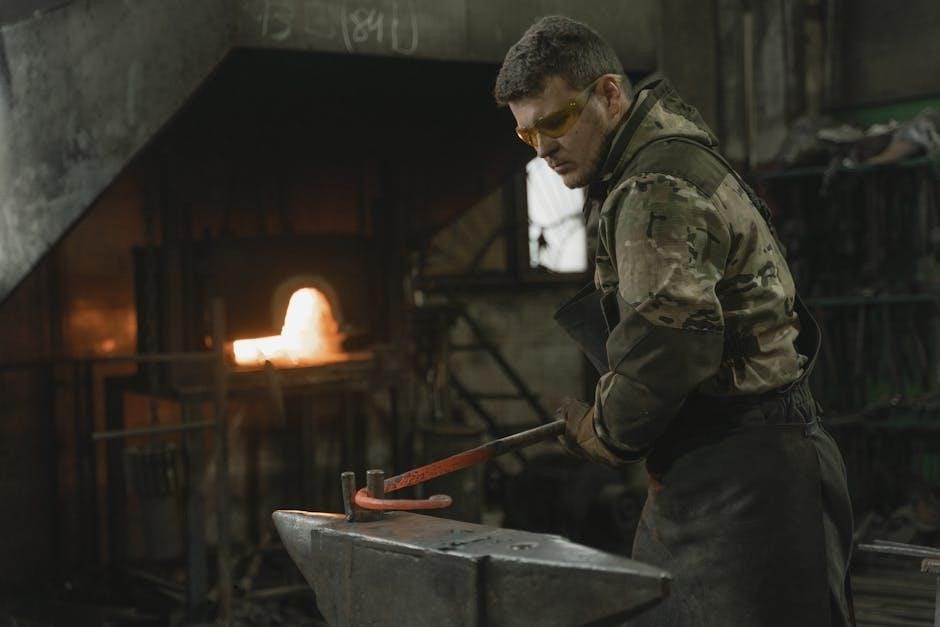
Goodman Furnace Instruction Manual: A Comprehensive Guide
Welcome! This comprehensive guide provides detailed instructions for your Goodman furnace, covering installation, operation, maintenance, and troubleshooting․ Following this manual ensures safe and efficient performance, extending the lifespan of your heating system․
Goodman furnaces are renowned for their reliability and cost-effectiveness in providing home heating solutions․ This section introduces you to the Goodman furnace family, highlighting their key features and benefits․ Goodman offers a range of models, each designed to meet specific heating needs and efficiency requirements․ Understanding the basic components and operational principles of your Goodman furnace is crucial for ensuring its optimal performance and longevity․
This manual serves as a comprehensive guide, providing essential information for homeowners and qualified technicians alike․ Whether you are a new owner or seeking to optimize your existing system, this guide offers valuable insights into the world of Goodman furnaces․ Familiarizing yourself with the information contained herein will empower you to confidently manage and maintain your heating system for years to come․ Remember to always prioritize safety and consult with qualified professionals when necessary․

Safety Precautions
Prioritizing safety is paramount when dealing with gas-fired appliances like Goodman furnaces․ This section outlines essential safety guidelines and procedures to prevent accidents and ensure safe operation of your furnace․
General Safety Guidelines
Before initiating any work on your Goodman furnace, it is imperative to disconnect all power to the unit․ Always turn off the gas supply at the manual shut-off valve located outside the furnace before performing any maintenance or repairs․ Only qualified, professionally trained HVAC technicians should install, adjust, alter, service, or operate the furnace․
Thoroughly read the entire instruction manual for specifics regarding installation and application․ Ensure proper ventilation around the furnace to prevent the accumulation of combustible gases․ Never store flammable materials near the furnace․ Regularly inspect the furnace for any signs of damage or wear, and promptly address any issues․
If you smell gas, immediately evacuate the area and contact your local gas utility company․ Do not attempt to locate the source of the leak yourself․
Gas Shut-Off Procedures
In the event of a suspected gas leak or when performing maintenance on your Goodman furnace, it is crucial to know how to properly shut off the gas supply․ First, locate the manual gas shut-off valve․ This valve is typically external to the furnace, usually on the gas supply pipe leading to the unit․
Using an appropriately sized wrench, carefully turn the valve handle 90 degrees until it is perpendicular to the gas pipe․ This position indicates that the gas flow is completely shut off․ Never use excessive force when turning the valve, as this could damage the valve or the gas pipe․
After shutting off the gas, allow ample time for any residual gas in the system to dissipate․ Before resuming operation, ensure that all connections are secure and that there are no detectable gas odors․ If you are unsure about any part of this procedure, contact a qualified HVAC technician․

Installation Instructions
Proper installation is crucial for optimal furnace performance․ This section outlines ventilation, wiring, and gas connection procedures․ Always adhere to local codes and manufacturer specifications for safety and efficiency․
Ventilation Requirements
Adequate ventilation is paramount for the safe and efficient operation of your Goodman furnace․ Proper venting ensures the removal of combustion byproducts, such as carbon monoxide, preventing potential health hazards and maintaining indoor air quality․ This furnace must be Category IV vented, do not vent it with a chimney․ Always refer to the installation manual shipped with the furnace for applicable vent connector diameter․
The venting system must comply with local codes and regulations․ Incorrect venting can lead to furnace malfunction, reduced efficiency, and dangerous conditions․ Ensure the venting system is free from obstructions and properly sealed to prevent leaks․ Inspect the vent system regularly for signs of corrosion or damage, and address any issues promptly․
Proper ventilation is crucial for both safety and the longevity of your furnace․ Failure to meet these requirements can void the warranty and compromise your family’s well-being․
Wiring Diagrams and Electrical Connections
Correct electrical connections are crucial for the safe and reliable operation of your Goodman furnace․ Always consult the wiring diagram specific to your model, located inside the furnace control panel or within the installation manual․ These diagrams provide detailed instructions for connecting the furnace to the power supply and other components, such as the thermostat and blower motor․
Ensure that all wiring complies with local electrical codes and regulations․ Use appropriately sized wiring and connectors to prevent overheating and potential fire hazards․ Before making any electrical connections, disconnect the power supply to the furnace to avoid electric shock․ Double-check all connections to ensure they are secure and properly insulated․
Incorrect wiring can lead to furnace malfunction, damage to components, and safety risks․ If you are not comfortable working with electrical wiring, consult a qualified electrician․ Verify that the blower amps, ID blower amps, and wire size comply with the furnace’s specifications․
Gas Connection Procedures
Proper gas connection is paramount for the safe and efficient operation of your Goodman furnace․ These procedures must be performed by a qualified professional to ensure compliance with local codes and regulations․ Before commencing any gas connection work, ensure the main gas supply to the furnace is completely shut off at the manual gas shut-off valve, external to the unit․
Inspect the gas supply line for any signs of damage or corrosion․ Use a pipe joint compound that is resistant to natural gas when making connections․ After connecting the gas line, test for leaks using a soap and water solution․ Apply the solution to all connections and check for bubbles, indicating a leak․
The furnace must be properly grounded to prevent static electricity buildup․ Adhere strictly to the manufacturer’s instructions and local codes during gas connection to avoid potential hazards and ensure optimal furnace performance․ Incorrect gas connections can lead to gas leaks, explosions, and carbon monoxide poisoning․

Operating Instructions
This section details how to safely and effectively operate your Goodman furnace․ It includes startup procedures, thermostat settings, and operational guidelines for optimal heating performance and energy efficiency․
Startup Procedures
Prior to initiating the startup sequence for your Goodman furnace, ensure that all installation procedures have been completed and verified by a qualified HVAC technician․ Confirm that the gas supply is connected and the manual gas shutoff valve, external to the furnace, is in the “open” position․ Check that the thermostat is properly configured and set to “heat” mode․
Inspect the area surrounding the furnace for any combustible materials or obstructions․ Ensure that the venting system is clear and unobstructed to allow for proper exhaust․ Next, power on the furnace by switching on the electrical breaker dedicated to the unit․
Observe the furnace control panel for any error codes or diagnostic indicators․ If present, consult the troubleshooting section of this manual before proceeding․ If no errors are indicated, set the thermostat to your desired temperature․ The furnace should initiate its startup sequence, which typically involves the inducer motor starting, followed by the ignition of the burners․ Monitor the furnace during the initial startup phase to ensure proper flame ignition and stable operation․
Thermostat Settings and Operation
Understanding your thermostat is crucial for efficient and comfortable operation of your Goodman furnace․ Familiarize yourself with its functions, including setting the desired temperature, selecting the appropriate mode (heat, cool, or auto), and programming schedules․ Ensure the thermostat is compatible with your furnace model and properly wired․
For heating, set the thermostat to “heat” mode and adjust the temperature to your preferred level․ The furnace will activate when the room temperature drops below the setpoint․ For cooling, select “cool” mode․ “Auto” mode automatically switches between heating and cooling based on the indoor temperature․
Programming your thermostat allows for customized temperature settings throughout the day, optimizing energy consumption and comfort․ Create schedules that lower the temperature during unoccupied periods and raise it when you’re home․ Some thermostats offer advanced features like Wi-Fi connectivity, enabling remote control via a smartphone or tablet․
Regularly check the thermostat’s batteries (if applicable) and replace them as needed․ Clean the thermostat periodically to remove dust and debris․ Refer to the thermostat’s user manual for specific instructions and advanced features․

Maintenance and Troubleshooting
Maintaining your Goodman furnace ensures optimal performance and longevity․ This section covers regular maintenance tasks and troubleshooting common issues, helping you keep your system running smoothly․
Regular Maintenance Tasks
To ensure your Goodman furnace operates efficiently and safely, regular maintenance is crucial․ These tasks not only extend the lifespan of your unit but also prevent costly repairs down the line․ Begin by regularly inspecting the air filter, replacing it every one to three months, or more frequently if you have pets or allergies․ A clean filter improves airflow and furnace performance․
Next, visually inspect the furnace for any signs of rust, corrosion, or damage․ Check the burner flames for a consistent blue color, indicating efficient combustion․ If the flames are yellow or orange, it could signal a problem with the gas supply or burner․
Additionally, ensure that the area around the furnace is clear of any flammable materials or obstructions․ Schedule a professional inspection and cleaning annually to address more complex maintenance needs and ensure optimal performance; These simple steps will help keep your Goodman furnace running smoothly for years․
Troubleshooting Common Issues
When your Goodman furnace encounters problems, troubleshooting can help identify and resolve common issues before calling a professional․ If the furnace fails to start, check the thermostat settings to ensure it’s set correctly and the batteries are fresh․ Verify that the power switch to the furnace is on and the circuit breaker hasn’t tripped․ Examine the air filter to ensure it’s clean, as a clogged filter can cause the furnace to overheat and shut down․
If the furnace starts but doesn’t produce heat, check the gas supply to ensure the valve is open․ Listen for any unusual noises, such as banging or rattling, which could indicate mechanical problems․ Look for error codes displayed on the furnace control board, referring to your manual for their meaning and recommended solutions․
If you suspect a gas leak, immediately turn off the gas supply and contact a qualified technician․ Remember, safety is paramount when dealing with gas appliances, and some issues require professional expertise․
Warranty Information and Registration
Understanding your Goodman furnace warranty is crucial․ Register your unit online to ensure coverage․ Keep records of installation and maintenance․ Contact Goodman directly for warranty claims and detailed information․
Warranty Registration Process
To fully benefit from your Goodman furnace warranty, registering your unit promptly is essential․ The registration process is straightforward and can be completed online via the Goodman Manufacturing website․ Locate the model and serial number of your furnace; this information is typically found on a rating plate attached to the unit․
During registration, you will need to provide your contact information, the installation date, and the name of the installing contractor․ Accurate information ensures a smooth warranty claim process should the need arise․ Registering your furnace within the specified timeframe, often 60 days from installation, unlocks the full warranty benefits, potentially including extended coverage on key components․
Keep a copy of your registration confirmation for your records․ Should you encounter any issues during the online registration, Goodman’s customer service is available to provide assistance․ Don’t delay; protect your investment by registering your Goodman furnace today․
Finding Goodman Furnace Manuals
Accessing your Goodman furnace manual is easy․ Explore online resources like the Goodman website for downloads․ Manuals provide essential information for operation, maintenance, and troubleshooting your unit․
Online Resources and Downloads
Finding the correct Goodman furnace manual is crucial for proper maintenance and troubleshooting․ The primary online resource is the official Goodman Manufacturing website, where a comprehensive library of manuals, technical specifications, and consumer brochures are readily available for download․ These resources cover a wide range of Goodman furnace models, ensuring you can find the specific documentation for your unit․
Additionally, various HVAC parts websites and online manual repositories offer Goodman furnace manuals for download․ These platforms often provide user manuals, service manuals, and operating guides in PDF format, enabling easy access and offline viewing․ When searching for your manual, ensure you have the correct model number to ensure compatibility and accurate information․ Always verify the source’s credibility to avoid outdated or incorrect information․
Remember that these manuals contain vital information․
